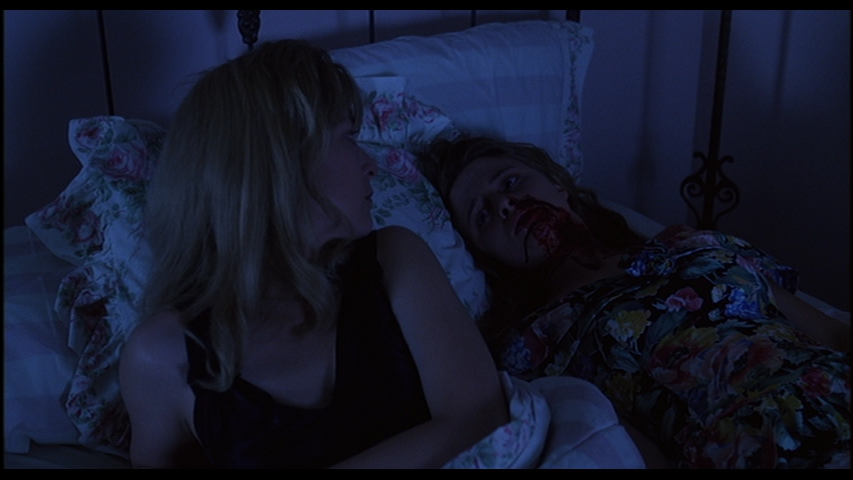At the beginning of this adventure, I told everybody that Fire Walk With Me was to be watched in the middle of the series, based on The Four Placements…
It’s time.
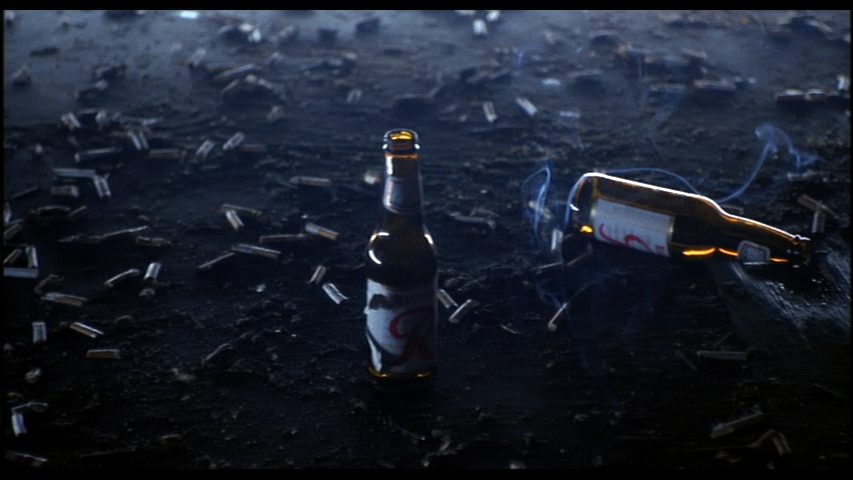 This is the place that makes the most emotional sense. Even if this is your first time through the series, almost all of the building blocks from the series that Lynch uses to build Fire Walk With Me are already in existence (the dream place, the convenience store, the creamed corn, the Tremonts, Teresa Banks, and Laura’s story. Later in the series, there’s talk about the Black Lodge and the White Lodge, and the good and evil spirits that possess us. Those lodges barely come into play with Fire Walk With Me. This is purely a movie about Leland/BOB, Teresa Banks and Laura Palmer.
This is the place that makes the most emotional sense. Even if this is your first time through the series, almost all of the building blocks from the series that Lynch uses to build Fire Walk With Me are already in existence (the dream place, the convenience store, the creamed corn, the Tremonts, Teresa Banks, and Laura’s story. Later in the series, there’s talk about the Black Lodge and the White Lodge, and the good and evil spirits that possess us. Those lodges barely come into play with Fire Walk With Me. This is purely a movie about Leland/BOB, Teresa Banks and Laura Palmer.
In the previous episode, Leland just confessed to his abusive childhood. He just confessed to killing Teresa Banks. He just confessed to repeatedly raping and ultimately killing Laura Palmer. The viewers’ emotions have been shredded to pieces and should be just a touch raw after watching Maddy get horrifically murdered and then watching Leland come to terms with what BOB has made him do. That’s just the right emotional wavelength for Fire Walk With Me. Raw, shaken, unnerved, disturbed, and maybe even a bit distraught.
Up to this point, Twin Peaks hasn’t seen Laura Palmer or Teresa Banks as much more than an abstract. Ronette Pulaski, the one survivor, is completely abandoned as soon as BOB tries killing her (back in episode 10!). From time to time, I ragged on how far away the series got from humanizing Laura Palmer and her suffering. In Fire Walk With Me, David Lynch finally gives her pain and her character a voice. If we solved her murder in Episode 16, this is David Lynch’s eulogy to Laura. But, this isn’t going to be any soft pedaled version of her trauma. Lynch is taking the gloves off, destroying the limitations of the television, and he’s gonna get dirty.
Deer Meadow and Teresa Banks
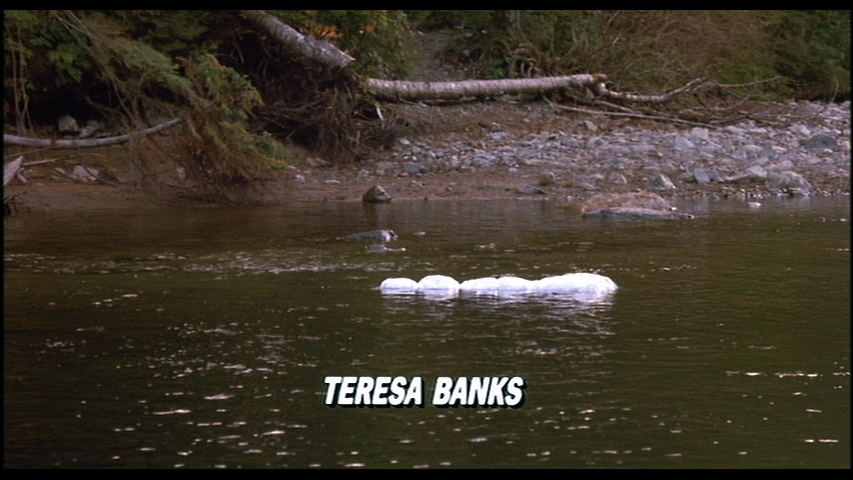 Teresa Banks is murdered in the first scene of Fire Walk With Me. Right off the bat, somebody plants an axe in the television screen playing static and Teresa Banks is murdered off screen. A day later, her body is found wrapped in plastic floating up a stream, just like Laura Palmer and Maddy Ferguson were.
Teresa Banks is murdered in the first scene of Fire Walk With Me. Right off the bat, somebody plants an axe in the television screen playing static and Teresa Banks is murdered off screen. A day later, her body is found wrapped in plastic floating up a stream, just like Laura Palmer and Maddy Ferguson were.
Deer Meadow, OR is no Twin Peaks, WA. Something is rotten in Deer Meadow, and its more than just the murder. The condition of Deer Meadow is what could have happened if the spirits weren’t trying to protect the good people of the town. The cops are corrupt (and, as we later find out, are drug runners). The residents of Deer Meadow are soured, grizzled, and tired of everything. The diner is broken. The police facilities are meager at best. The suburban neighborhood where Laura and Donna lived has been replaced by the most run down trailer park you’ve ever seen.
More than that, Deer Meadow is the exact inverse of Twin Peaks. This is what Twin Peaks would have been like in a different setting. These first 40 minutes have the exact elements of Twin Peaks, but they’re tweaked for a poor part of town. Teresa Banks was not Laura Palmer. At this point in her life, she was a nomad who was estranged from her family. She had no parents, no next of kin, and she wasn’t a model citizen. She wasn’t even a model waitress, as she was frequently late to her shift at Hap’s Diner.
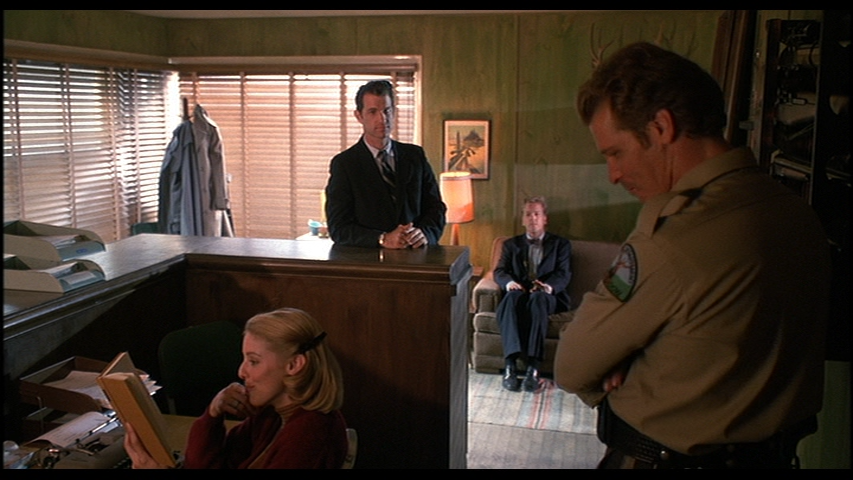 The cops are also not Twin Peaks cops. They have a secretary who reads a book and giggles a lot, but this one has straight blonde hair compared to Lucy’s frizzy brunette. The secretary is also not helpful and the coffee in the pot is at least 3 days old; coffee is the life thread of every town, and this coffee is stale and dead – nobody cares about the life or the coffee. Sheriff Cable is a big brute who takes pride in being able to bend steel. Unlike Harry S. Truman, he doesn’t actually care about Teresa Banks, solving her crime, or helping out the Feds in any way, shape or form. His deputy is no Andy Brennan. Sure, he may be dating the secretary but he tries to stop the Feds in any way he can. And, as we later find out, he is an active drug mule for the cops.
The cops are also not Twin Peaks cops. They have a secretary who reads a book and giggles a lot, but this one has straight blonde hair compared to Lucy’s frizzy brunette. The secretary is also not helpful and the coffee in the pot is at least 3 days old; coffee is the life thread of every town, and this coffee is stale and dead – nobody cares about the life or the coffee. Sheriff Cable is a big brute who takes pride in being able to bend steel. Unlike Harry S. Truman, he doesn’t actually care about Teresa Banks, solving her crime, or helping out the Feds in any way, shape or form. His deputy is no Andy Brennan. Sure, he may be dating the secretary but he tries to stop the Feds in any way he can. And, as we later find out, he is an active drug mule for the cops.
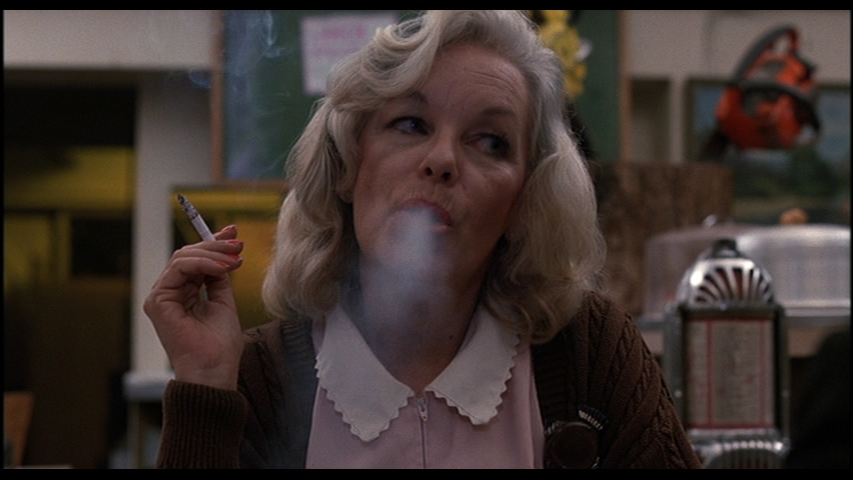 At Hap’s Diner, they meet Irene (Not Norma), a grizzled old waitress who runs this diner. As she so helpfully intones with a smile, “You wanna hear about our specials? We don’t have any.” She’s a chain-smoking coffee drinking run down waitress who has seen too much to be impressed by anything. She tells the Feds that Teresa had a coke habit. At Teresa’s trailer park, the feds are given disgustingly strong coffee that they throw down the sink as soon as is respectful. A mysterious lady with an ice pack over her eye steps into the trailer and shudders before slinking off; she might be this town’s Nadine. This town’s businessman is a whiny complaining Harry Dean Stanton who who has handwritten a message not to disturb him early in the morning.
At Hap’s Diner, they meet Irene (Not Norma), a grizzled old waitress who runs this diner. As she so helpfully intones with a smile, “You wanna hear about our specials? We don’t have any.” She’s a chain-smoking coffee drinking run down waitress who has seen too much to be impressed by anything. She tells the Feds that Teresa had a coke habit. At Teresa’s trailer park, the feds are given disgustingly strong coffee that they throw down the sink as soon as is respectful. A mysterious lady with an ice pack over her eye steps into the trailer and shudders before slinking off; she might be this town’s Nadine. This town’s businessman is a whiny complaining Harry Dean Stanton who who has handwritten a message not to disturb him early in the morning.
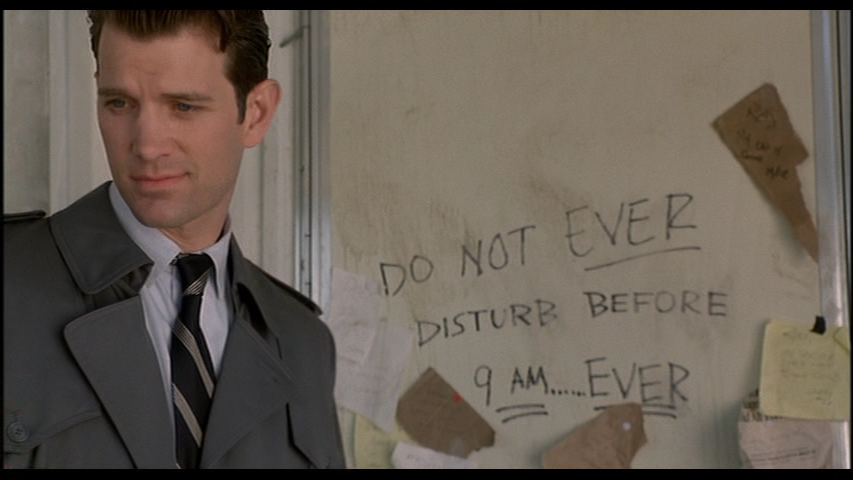 Even the feds are inverse of Twin Peaks’ feds. Albert the Lovable Cynic is now Sam the Lovable Aspie. He’s tall, young, blonde, and naive. He makes plenty of observations but has no real world grounding for them. He doesn’t see how the world is better or worse – he intones that Irene’s coffee drinking and smoking are on the same level as cocaine use – and his observations are merely to make sense of the world. As Dale put it in the pilot, Albert is a little more on the ball than Sam. Dale Cooper is replaced by Chester Desmond (DC becomes CD), a tall, handsome cynic who isn’t nearly as happy go lucky. He has people skills, but he also doesn’t take shit. Just before Albert appears in Twin Peaks, Dale tweaks Harry Truman’s nose as a sign of affection. Here, Chester wrenches the deputy’s nose to make him sit down and behave.
Even the feds are inverse of Twin Peaks’ feds. Albert the Lovable Cynic is now Sam the Lovable Aspie. He’s tall, young, blonde, and naive. He makes plenty of observations but has no real world grounding for them. He doesn’t see how the world is better or worse – he intones that Irene’s coffee drinking and smoking are on the same level as cocaine use – and his observations are merely to make sense of the world. As Dale put it in the pilot, Albert is a little more on the ball than Sam. Dale Cooper is replaced by Chester Desmond (DC becomes CD), a tall, handsome cynic who isn’t nearly as happy go lucky. He has people skills, but he also doesn’t take shit. Just before Albert appears in Twin Peaks, Dale tweaks Harry Truman’s nose as a sign of affection. Here, Chester wrenches the deputy’s nose to make him sit down and behave.
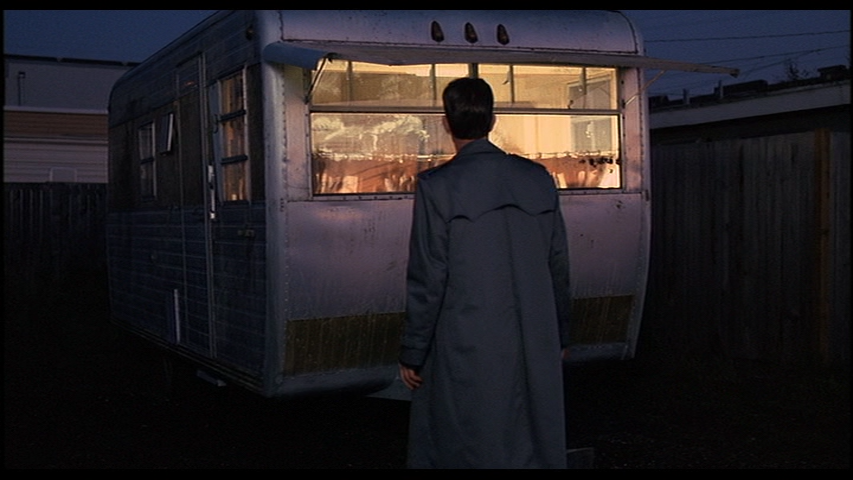 At the trailer park, Teresa was surrounded by the Black Lodge. All over the park, electricity ebbed and flowed through the various cables, with a large electric pole dead center. The Tremonts are staying at the trailer park, but are the Chalfonts who have always stayed there since time immemorial. Under their trailer, Chester finds the ring with an owl marking on it; the type of marking that’s later associated with the black lodge. As soon as he reaches for it, he disappears. When Dale arrives to investigate Chester’s disappearance, he finds the words Let’s Rock, the same words that The Man From Another Place states at the beginning of Dale’s first dream on Day 3.
At the trailer park, Teresa was surrounded by the Black Lodge. All over the park, electricity ebbed and flowed through the various cables, with a large electric pole dead center. The Tremonts are staying at the trailer park, but are the Chalfonts who have always stayed there since time immemorial. Under their trailer, Chester finds the ring with an owl marking on it; the type of marking that’s later associated with the black lodge. As soon as he reaches for it, he disappears. When Dale arrives to investigate Chester’s disappearance, he finds the words Let’s Rock, the same words that The Man From Another Place states at the beginning of Dale’s first dream on Day 3.
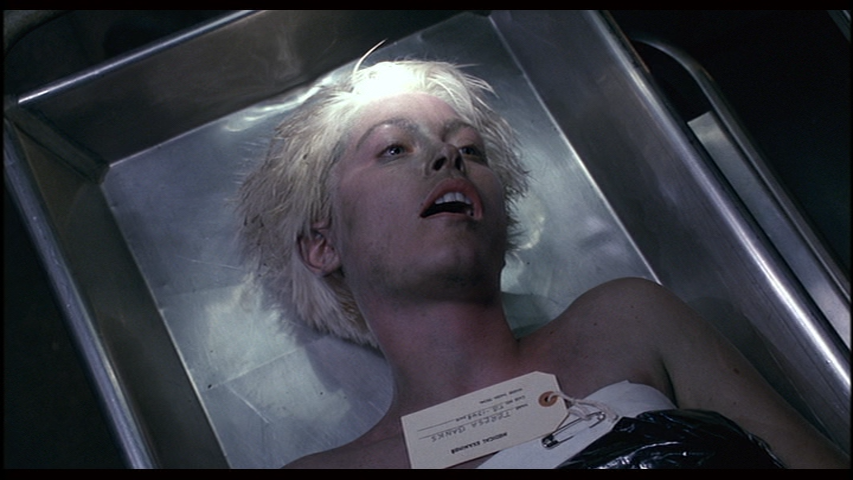 Later in the movie, Leland/BOB remembers how he met and how he killed Teresa Banks. Like Laura, Teresa was a prostitute who advertised in Flesh World alongside Ronette. Leland hired her for a few sessions at the Diamond Motel, just out of Twin Peaks. During one session, she said that she could bring along two freaky friends and give Leland a four-way as long as he paid a little extra money. And, really, who wouldn’t want that if they could afford it? But, on the day of the booking, Leland looked into the motel room, and saw Laura and Ronette sitting on the bed…and then he killed Teresa at her trailer park.
Later in the movie, Leland/BOB remembers how he met and how he killed Teresa Banks. Like Laura, Teresa was a prostitute who advertised in Flesh World alongside Ronette. Leland hired her for a few sessions at the Diamond Motel, just out of Twin Peaks. During one session, she said that she could bring along two freaky friends and give Leland a four-way as long as he paid a little extra money. And, really, who wouldn’t want that if they could afford it? But, on the day of the booking, Leland looked into the motel room, and saw Laura and Ronette sitting on the bed…and then he killed Teresa at her trailer park.
The Divine and The Damned
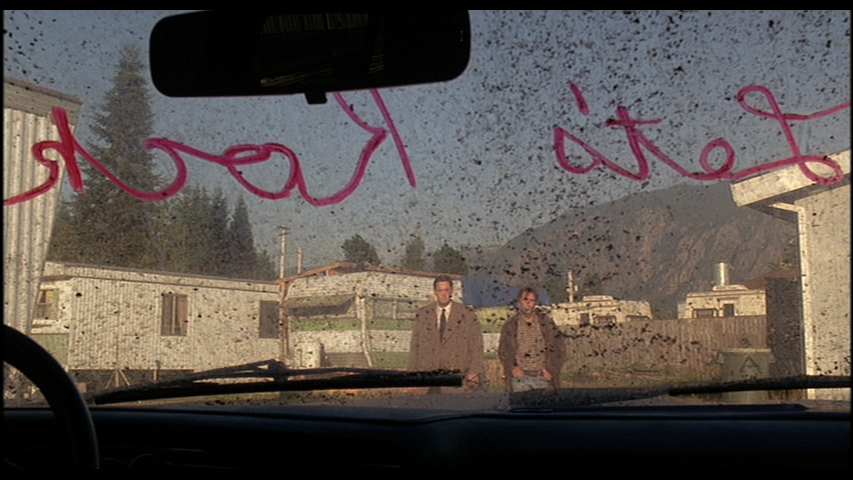 All of the events in Twin Peaks and Fire Walk With Me can be easily explained without the thread of the spiritual. The blue rose of the case, the spirituality and the mythology of Twin Peaks is the guide to understanding the complex humanity and inhumanity that is laid out before us. Without the philosophical underpinnings, Twin Peaks would be just another cop show focusing on a father killing his daughter. But, David Lynch and Mark Frost strive for something deeper and more humane than that. He wants to understand the human psyche, in as much as he can.
All of the events in Twin Peaks and Fire Walk With Me can be easily explained without the thread of the spiritual. The blue rose of the case, the spirituality and the mythology of Twin Peaks is the guide to understanding the complex humanity and inhumanity that is laid out before us. Without the philosophical underpinnings, Twin Peaks would be just another cop show focusing on a father killing his daughter. But, David Lynch and Mark Frost strive for something deeper and more humane than that. He wants to understand the human psyche, in as much as he can.
They believe that there are extraordinary unseen forces that constantly struggle for the human soul, a battle between one’s demons and a fight between good and evil. All of the various religions and belief systems strive to make sense of a world where we have words like coincidence to describe two related actions happening without knowledge or direct relation to each other. We have words like conscience and consciousness to describe mental states. We have words like “luck” to describe a human who has beneficial things happen to them. Humans possess a complex map of emotions for which we’ve developed different explanations and coping mechanisms.
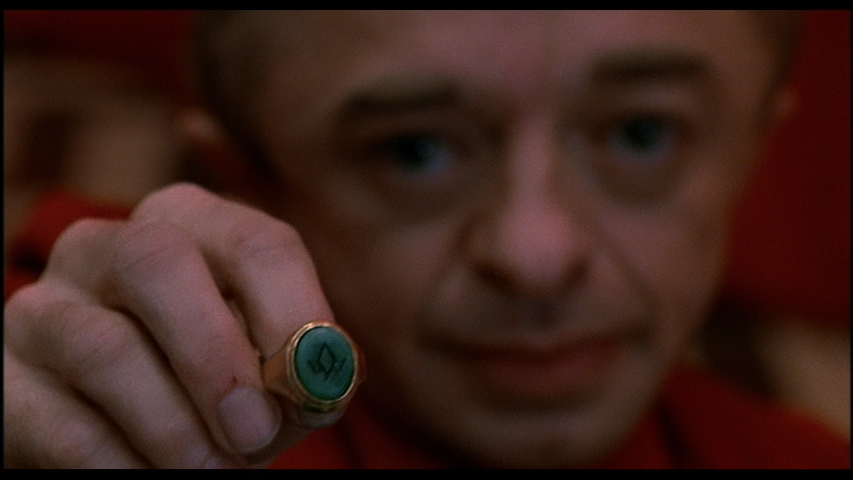
Lynch and Frost combined a variety of philosophies – western Judeo-Christianity, Asian Taoism, Buddhism, gambler’s beliefs, and even Native American beliefs – into a melting pot and came out with a heady battle of good and evil that abstracts and dives in to our deepest core of humanity. The Black Lodge and The White Lodge are a version of Heaven and Hell made into a baser form. The demons of hell (MIKE, BOB, the Tremonds, etc) feed from fear and sorrow, while the angels of heaven (the white horse, the Giant, the angels) try to guide people along the righteous path. The demons are harder to resist and difficult to identify while the angels are spiritual and more hands off with their relations.
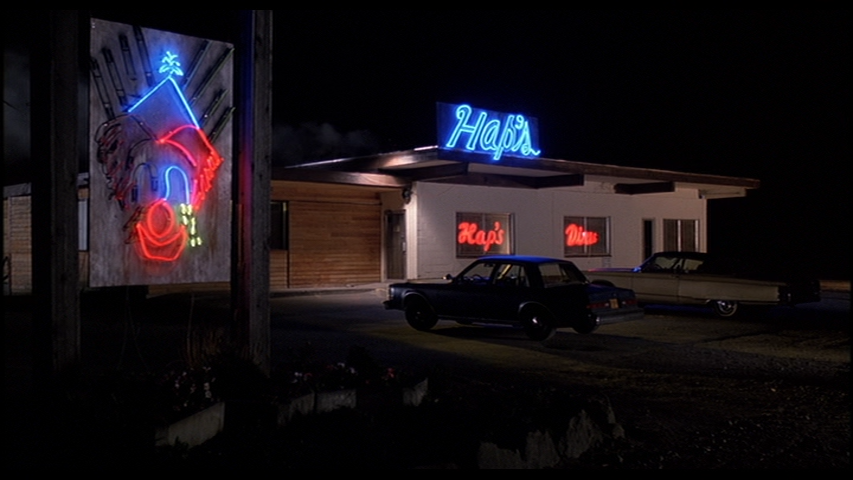 The idea of duality is weaved throughout Fire Walk With Me. Consider Hap’s Diner. Outside the diner is a huge neon sign of a clown, half burned out. The clown is an image of joy and merriment, one of jokes and laughter…but the clown here is of a sad clown, actively crying electric yellow tears. Has joy died and left to cry? Or, perhaps there can be sadness in joy and joy in sadness. The trickster clown exists in the jumping man, the backwards speaking of the Black Lodge, Coma Leo in a clown hat with cake on his face, and in various other places throughout the series. Both Tibetan and Native American philosophies have clown characters who provoke for merriment and encourage a deeper thinking through their use of nonsensical techniques. In certain Native American belief structures, these clowns also control electricity and lightning, much as the Black Lodge Denizens do here.
The idea of duality is weaved throughout Fire Walk With Me. Consider Hap’s Diner. Outside the diner is a huge neon sign of a clown, half burned out. The clown is an image of joy and merriment, one of jokes and laughter…but the clown here is of a sad clown, actively crying electric yellow tears. Has joy died and left to cry? Or, perhaps there can be sadness in joy and joy in sadness. The trickster clown exists in the jumping man, the backwards speaking of the Black Lodge, Coma Leo in a clown hat with cake on his face, and in various other places throughout the series. Both Tibetan and Native American philosophies have clown characters who provoke for merriment and encourage a deeper thinking through their use of nonsensical techniques. In certain Native American belief structures, these clowns also control electricity and lightning, much as the Black Lodge Denizens do here.
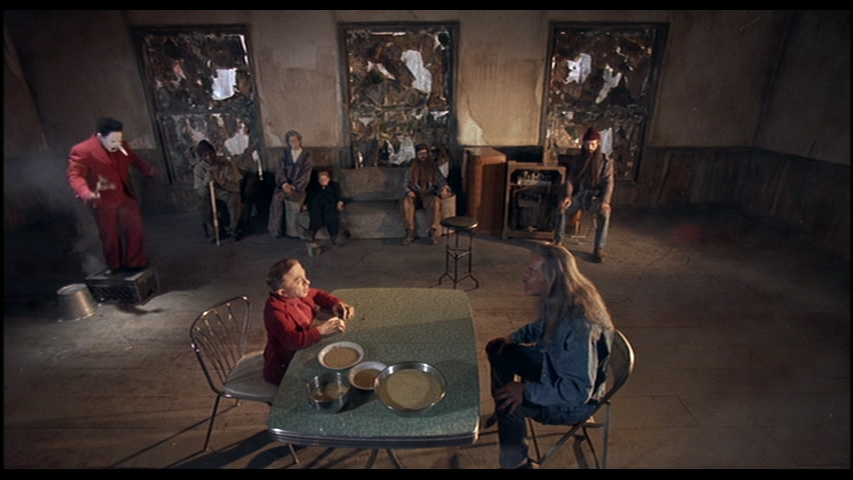 Philip Jeffries makes an appearance between the Deer Meadow and the Twin Peaks segments, a split right between the two, to rant about a meeting he saw above a convenience store with the Black Lodge denizens. The Man From Another Place (Mike’s evil left arm) and Bob sat at a Formica table with bowls of garmonbozia. Pierre the Magician also had a bowl at his feet. They’re having a party of sorts, and they’re trying to feed off the next group of people marked by their ring. The ring of the Black Lodge, marked with an owl.
Philip Jeffries makes an appearance between the Deer Meadow and the Twin Peaks segments, a split right between the two, to rant about a meeting he saw above a convenience store with the Black Lodge denizens. The Man From Another Place (Mike’s evil left arm) and Bob sat at a Formica table with bowls of garmonbozia. Pierre the Magician also had a bowl at his feet. They’re having a party of sorts, and they’re trying to feed off the next group of people marked by their ring. The ring of the Black Lodge, marked with an owl.
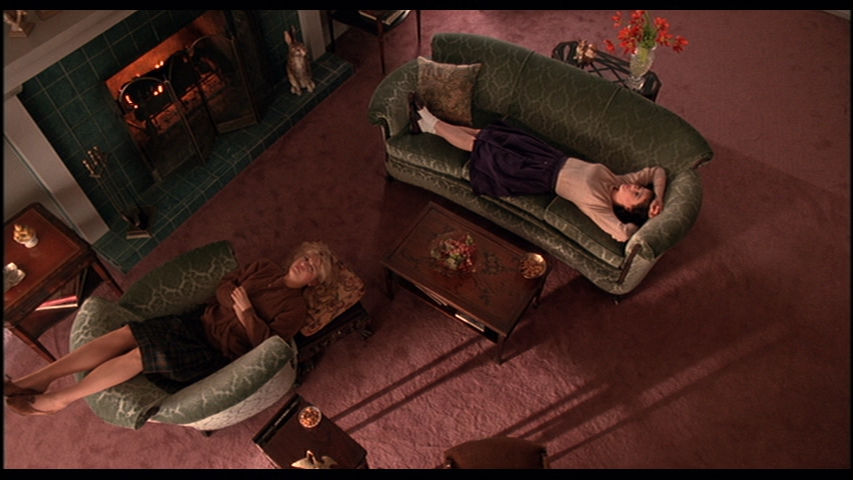 There are essays upon essays that dive into the deeper specific interpretations of Fire Walk With Me and how its mysticism feeds off human understanding, but I keep coming back to the conversation between the police after Leland’s demise in Episode 16. Are the Black Lodge denizens just a representation of “The Evil That Men Do”? Is it easier to think about these mythic representations as manipulating the human condition or to accept that a man would rape and murder his own daughter? Twin Peaks is ultimately a deeply mythic representation to help us deal with the real world ugliness of human existence, and there are patterns to be mined from it. Finding deeper meanings and clues and mythologies throughout the show is a fun world-building exercise, similar to the complicated myths of the Grecian and Roman gods.
There are essays upon essays that dive into the deeper specific interpretations of Fire Walk With Me and how its mysticism feeds off human understanding, but I keep coming back to the conversation between the police after Leland’s demise in Episode 16. Are the Black Lodge denizens just a representation of “The Evil That Men Do”? Is it easier to think about these mythic representations as manipulating the human condition or to accept that a man would rape and murder his own daughter? Twin Peaks is ultimately a deeply mythic representation to help us deal with the real world ugliness of human existence, and there are patterns to be mined from it. Finding deeper meanings and clues and mythologies throughout the show is a fun world-building exercise, similar to the complicated myths of the Grecian and Roman gods.
Perhaps, what we need to know, is that there is good and evil in this world that constantly push and pull through temptation of our basest desires. The 7 Deadly Sins, so to speak. The evil will tempt, the good will help, and we have to figure out which is which; and we have to remember…they can also lie.
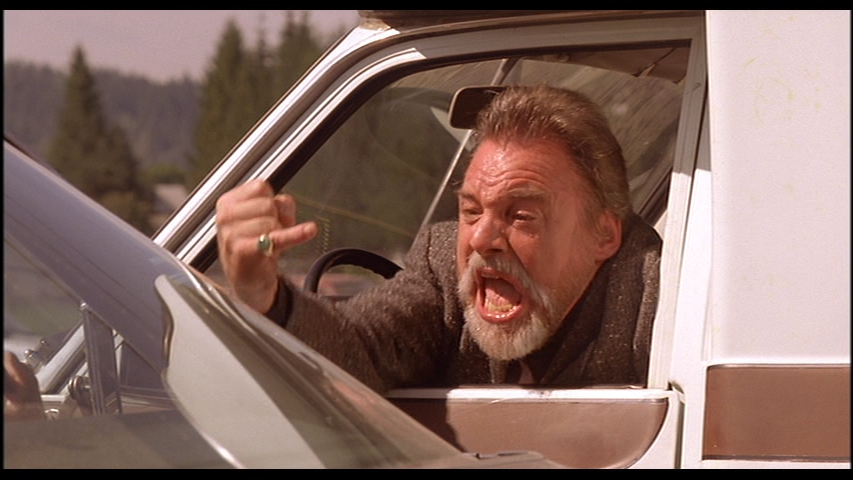 The one big question mark in Fire Walk With Me is how it depicts MIKE. MIKE is similar to the Christian Archangel Michael, who fights demons from hell throughout history. But, is he a source of good? In the series he says he had a coming to God moment when he cut off his evil left arm, but then he’s seen in the end eating from people’s pain and suffering. Or, at least the arm is through him. What are we to make of MIKE? And did he ultimately lead to Laura’s salvation?
The one big question mark in Fire Walk With Me is how it depicts MIKE. MIKE is similar to the Christian Archangel Michael, who fights demons from hell throughout history. But, is he a source of good? In the series he says he had a coming to God moment when he cut off his evil left arm, but then he’s seen in the end eating from people’s pain and suffering. Or, at least the arm is through him. What are we to make of MIKE? And did he ultimately lead to Laura’s salvation?
Laura Palmer
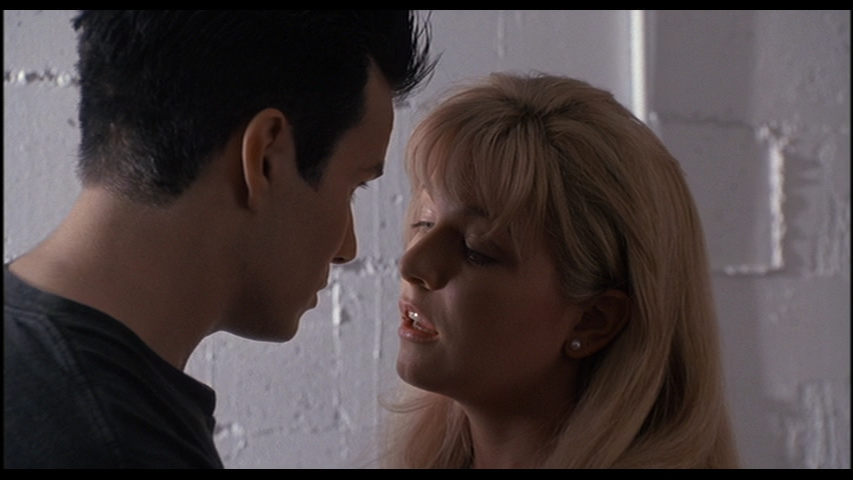 Laura Palmer is finally alive in Twin Peaks, but the signs that she’s in trouble begin almost immediately. She does cocaine in school, she makes out with James while in a towel behind the school gym, and she’s already belittling Bobby for not being able to keep up with her attitude. She puts on a good front, but everybody can tell that she’s a renegade girl living a split life between her good citizenship and her total bad girl dark side. Somebody who doesn’t look too deeply could reduce her to that rich-Catholic-who-secretly-loves-wild-sex type of stereotype. She’s just rebelling because she tries so hard to be good otherwise.
Laura Palmer is finally alive in Twin Peaks, but the signs that she’s in trouble begin almost immediately. She does cocaine in school, she makes out with James while in a towel behind the school gym, and she’s already belittling Bobby for not being able to keep up with her attitude. She puts on a good front, but everybody can tell that she’s a renegade girl living a split life between her good citizenship and her total bad girl dark side. Somebody who doesn’t look too deeply could reduce her to that rich-Catholic-who-secretly-loves-wild-sex type of stereotype. She’s just rebelling because she tries so hard to be good otherwise.
We, the audience, know that her rebellion more than that. Her rebellion isn’t just her rebelling; her rebellion is her escape from the horrors of her home life. Her father is a relatively upper-middle-class lawyer who earns a healthy living working for one of the wealthiest families of the town. He also emotionally abuses his family, drugs his wife, and rapes his daughter on a regular basis. Over his last two episodes, Leland/BOB became a cartoonish villain ready to explode out of his own skin. In Fire Walk With Me, he’s a dominating and manipulating force of fatherhood gone wrong. He isn’t the cartoon monster like we would guess somebody like him to be. He’s an actual monster living in our midst.
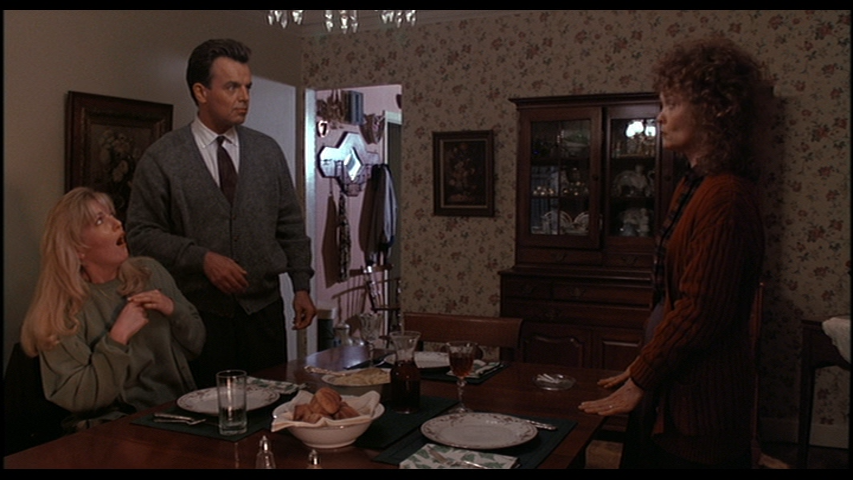 The most illustrative scene of Leland as a father gone wrong is the dinner scene. Laura is already putting the pieces of the puzzle together and figuring out who is abusing her, and Leland/BOB is becoming more and more open about their true intentions. When Laura arrives home from Donna’s for dinner, Leland immediately starts prying into her day, then notices Laura’s half heart necklace. He plays with it and asks if its from one of her lovers. And, finally, he tells Laura to wash her hands for dinner. In one reading, Leland could have been seen as a jealous and over protective father who has to know what their daughter is up to. After all, the ideal for American families is for parents to become involved in their kid’s lives. But, in the delivery given in the film, Leland is leering and manipulating and emotionally destroying Laura AND Sarah, who watches on. He knows he’s under their skin, and he’s exercising his control over the family.
The most illustrative scene of Leland as a father gone wrong is the dinner scene. Laura is already putting the pieces of the puzzle together and figuring out who is abusing her, and Leland/BOB is becoming more and more open about their true intentions. When Laura arrives home from Donna’s for dinner, Leland immediately starts prying into her day, then notices Laura’s half heart necklace. He plays with it and asks if its from one of her lovers. And, finally, he tells Laura to wash her hands for dinner. In one reading, Leland could have been seen as a jealous and over protective father who has to know what their daughter is up to. After all, the ideal for American families is for parents to become involved in their kid’s lives. But, in the delivery given in the film, Leland is leering and manipulating and emotionally destroying Laura AND Sarah, who watches on. He knows he’s under their skin, and he’s exercising his control over the family.
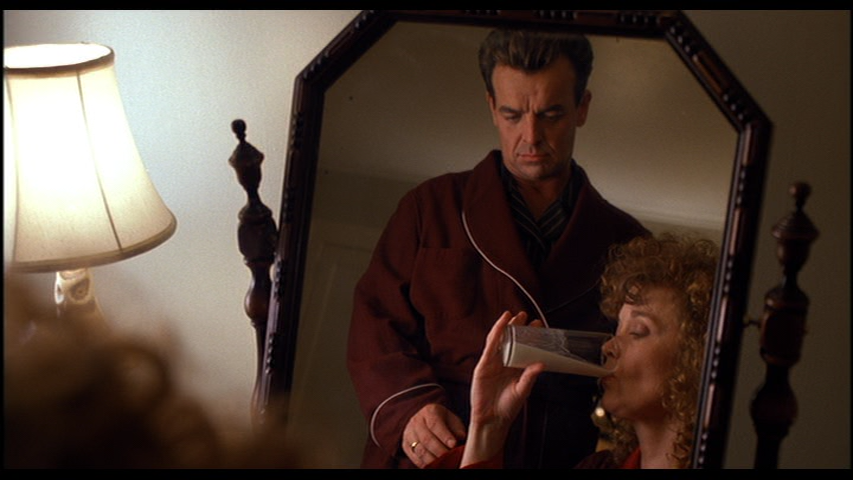 Later, he comes into Laura’s bedroom and cries while apologizing for his behavior and saying how much he loves her. This is just as he’s forcing Sarah to drink drugged milk so he can sneak into Laura’s room later that night and rape her. Laura thinks its BOB raping her, as usual. Instead, midway through the scene, for the first time, she sees BOB as Leland. Finally, the barriers are breaking down, and she knows that her father is also the man who has been raping her since before she was 12. Sometimes you don’t want to believe your parents are pieces of shit and doing things to harm you. And, when you get older with more context, you come to terms with the realization that you’ve been harmed for years by the very people meant to protect you.
Later, he comes into Laura’s bedroom and cries while apologizing for his behavior and saying how much he loves her. This is just as he’s forcing Sarah to drink drugged milk so he can sneak into Laura’s room later that night and rape her. Laura thinks its BOB raping her, as usual. Instead, midway through the scene, for the first time, she sees BOB as Leland. Finally, the barriers are breaking down, and she knows that her father is also the man who has been raping her since before she was 12. Sometimes you don’t want to believe your parents are pieces of shit and doing things to harm you. And, when you get older with more context, you come to terms with the realization that you’ve been harmed for years by the very people meant to protect you.
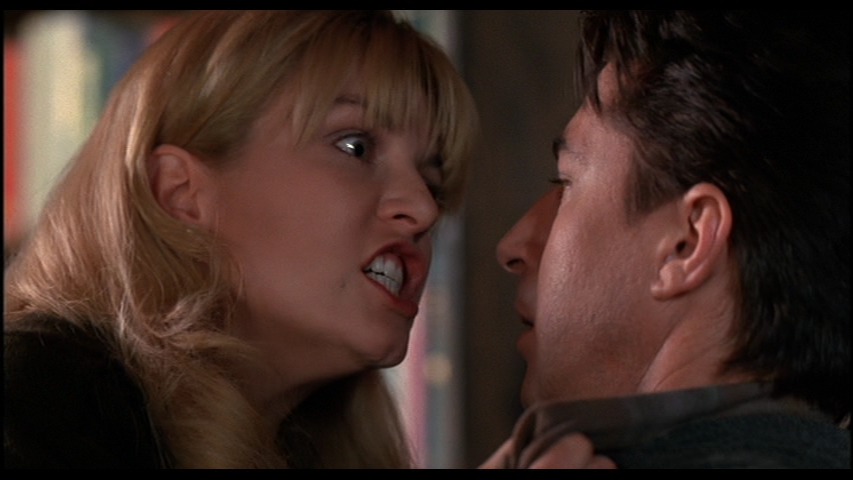 Laura tries to find solace in so many different ways. She tries to find solace through drinking, through drugs, through smoking, through prostitution. She needs to find her own ownership through her moral impurities. These deviations, alone, aren’t actually all that impure…except that Laura does them out of desperation. She fucks other men to gain control over her sexuality. She drinks and does drugs to control the complicated emotions she has towards life left behind from all the various unwanted encounters with BOB. Laura tries to find solace by fracturing her faces into various personas, showing a different side to each of her loved ones, from Donna to Jacques.
Laura tries to find solace in so many different ways. She tries to find solace through drinking, through drugs, through smoking, through prostitution. She needs to find her own ownership through her moral impurities. These deviations, alone, aren’t actually all that impure…except that Laura does them out of desperation. She fucks other men to gain control over her sexuality. She drinks and does drugs to control the complicated emotions she has towards life left behind from all the various unwanted encounters with BOB. Laura tries to find solace by fracturing her faces into various personas, showing a different side to each of her loved ones, from Donna to Jacques.
This is Laura’s story, it’s about the horror that she went through in her final days as she unearthed her own mystery. But, more than that, Fire Walk With Me is Laura’s salvation. In the past 16 episodes of the series, Laura was never given redemption. The show ripped her apart and made her life abstract as hell in the absence, and never bothered to make her a whole person. Fire Walk With Me allows her that, and gives her a way out.
Whatever BOB and the Dark Lodge inhabitants are – manifestations of man’s evil, actual spirits, or somewhere in between – they pass on from person to person through traumatic experience. Robertson, the grey haired man, molested Leland as a child and Leland allowed that absence of innocence to stir within him and rot away his conscience. That trauma is BOB. The trauma of Leland’s molestation is enacted upon Laura as rape. But BOB only gives Laura one choice: give in and become a monster herself or he’ll kill her. Death is the only way she can escape BOB’s clutches.
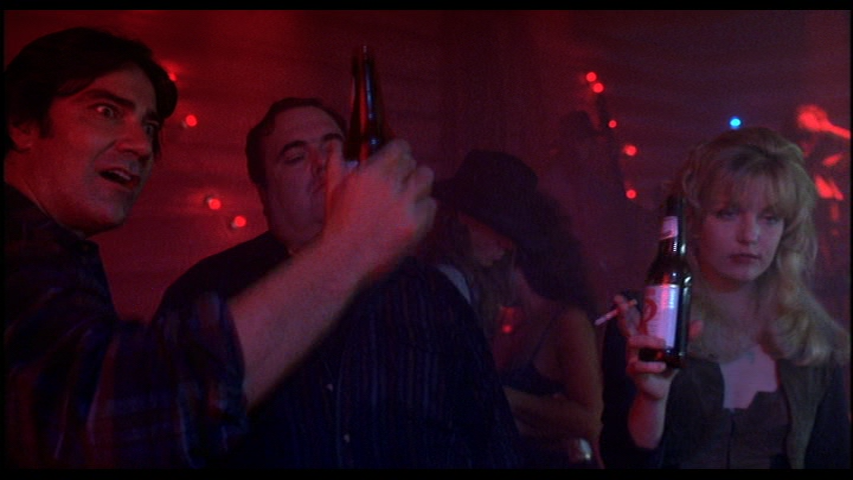 At one point, she almost turns into BOB. One evening, she dresses sexy and heads over to the Roadhouse to fuck away her problems. There are a couple of boys in town who want to fuck the Homecoming Queen, and she’s ready to take them on. Donna is also at The Roadhouse and sees her crying as she initiates the exchange, and comes over to help…but ends up joining in on the fun. They make it across the border to an all night underground club where the men drug Donna with Laura’s help, who watches them drug her and then get ready to fuck her in the middle of the club. Laura finally comes to her senses and runs to protect her friend, the friend she almost corrupted, from her own dissatisfied life. Laura has to resist her own impulses before the demons take her away.
At one point, she almost turns into BOB. One evening, she dresses sexy and heads over to the Roadhouse to fuck away her problems. There are a couple of boys in town who want to fuck the Homecoming Queen, and she’s ready to take them on. Donna is also at The Roadhouse and sees her crying as she initiates the exchange, and comes over to help…but ends up joining in on the fun. They make it across the border to an all night underground club where the men drug Donna with Laura’s help, who watches them drug her and then get ready to fuck her in the middle of the club. Laura finally comes to her senses and runs to protect her friend, the friend she almost corrupted, from her own dissatisfied life. Laura has to resist her own impulses before the demons take her away.
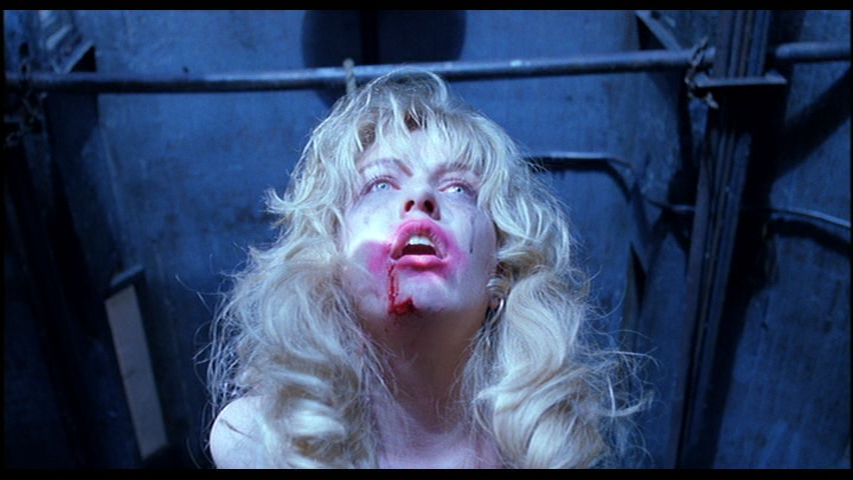 In the end, after she’s been tied up and fucked by Leo and Jacques, when her father is torturing and beating her senseless, she still has the impulse not to give in. That this is hell, but she doesn’t have to embody it. The angels save Ronette from the horror of this life because its not her father doing the killing. Those angels can’t save Laura from Leland/BOB, except through death. Laura has to die to satisfy everybody. Laura doesn’t let the Black Lodge win, and she pays the ultimate price for it.
In the end, after she’s been tied up and fucked by Leo and Jacques, when her father is torturing and beating her senseless, she still has the impulse not to give in. That this is hell, but she doesn’t have to embody it. The angels save Ronette from the horror of this life because its not her father doing the killing. Those angels can’t save Laura from Leland/BOB, except through death. Laura has to die to satisfy everybody. Laura doesn’t let the Black Lodge win, and she pays the ultimate price for it.
Stray Notes
- Perhaps what we need to pull from this is Agent Cooper’s presence in the Black Lodge was for 25 years, and that his evil doppelganger has been out and about for years. David Lynch has made Fire Walk With Me required viewing for the new Showtime series, and there is so much here that I can’t predict where he’s going.
- I still want to know what happened to Judy.
- I wrote about The Missing Pieces last year (it’s an interesting companion piece to this essay, IMHO). The big takeaways from The Missing Pieces actually may have more to do with the new season than actual Fire Walk With Me. The Missing Pieces brings back the town of Twin Peaks to indict them for not rescuing Laura, but it has a denouement that gives the Owl Ring to Annie to protect her from the evil spirits. The meaning of the Owl Ring varies, but it has power. It saved Laura, and it may have saved Annie too. But, Psycho Coop was out on a rampage when the movie left.
- The Missing Pieces and Fire Walk With Me were originally a huge setup for a potential Season 3 back in the early 90s. With Fire Walk With Me‘s commercial and critical failure (thank God for critical reappraisals), that season disappeared. Now, we’re all curious with what will happen in the new series…but, we still have to get through the rest of Season 2.
- I have so many images screencapped from this movie. SO MANY IMAGES,


